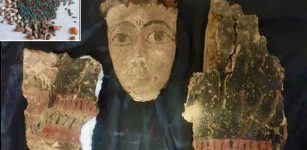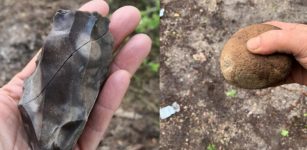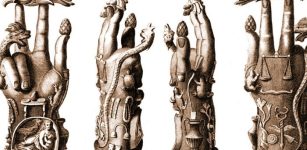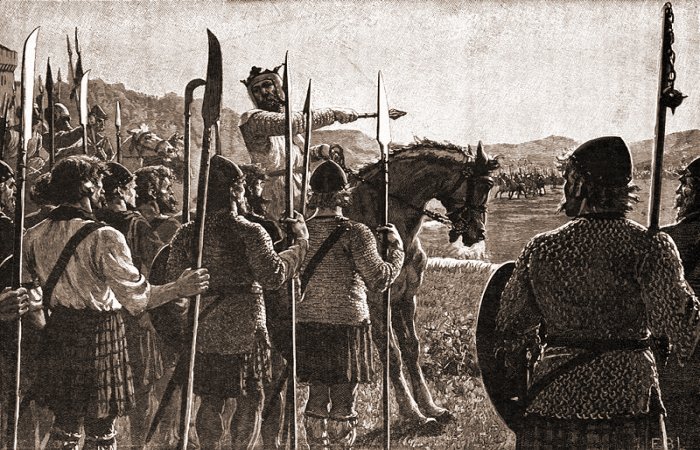Robert The Bruce: Mighty King Of Scots And Great Scottish Hero
Ellen Lloyd - AncientPages.com - He became the King of Scots and fought one of the most significant battles in English and Scottish history. He was a target of a manhunt and had to hide in the Highlands. He murdered his rival in a Church and was excommunicated by the Pope.
Robert the Bruce. Stirling Castle, Stirling, Scotland - Image credit: Otter - source
It is the story of the mighty King of Scots - Robert the Bruce. Inspired by a spider, Robert the Bruce gained new strength and returned to seek revenge.
Robert I, popularly known as Robert the Bruce, was born on July 11, 1274, at Turnberry Castle into the Scottish nobility. He was one of the greatest Scottish heroes and reigned as the King of Scots until he died in 1329. He led Scotland during the Wars of Scottish Independence against the English, claiming the Scottish throne in 1306 as the fourth great-grandson of David I of Scotland. He was the King who lived to see Scotland as an Independent Nation.
First Interregnum In Scotland - A Time Without A Successor To The Throne Of Scotland
Robert, the Bruce family, were not native Scots. His mother's family was of Scots Gaelic descent, and his father, who had come over to England with the army of William the Conqueror, had roots in Normandy.
William the Conqueror rewarded Robert's father by granting him lands in Yorkshire, but the family had added to this inheritance by acquiring many lands in Huntingdonshire and Annandale, Scotland.
During the First Interregnum (1290-1292), a historical period when there was no successor to the Scottish throne, the family of Robert the Bruce strengthened their position in the country. Bruce's grandfather was one of the claimants to the Scottish throne.
Bruce reading stories to his followers; from a 19th-century Scottish history book. Marshall, H. E. (Henrietta Elizabeth), b. 1876. Published 1907 - Public Domain
The English King, Edward I, authorized to arbitrate in the dispute and chose John Balliol to be King, which Bruce and his father did not accept. Balliol was considered to be a puppet King, deliberately set up to be manipulated by the formidable Edward and to rule Scotland according to his wishes.
Second Interregnum And A Long Period Of Many Battles
Edward then ruled Scotland as a province of England. Robert, the Bruce family, decided instead to support King Edward I's invasion of Scotland in 1296 to force Balliol to abdicate. It led to the Second Interregnum when Scotland had no king for ten years. A series of governors instead ruled the country. Edward I, King of England, sought to take advantage of the situation to bring Scotland under English control.
Various battles began, and this period of warfare between the Scots and England - known as the Wars of Independence - lasted until the 1320s.
Robert the Bruce Murdered His Rival For The Throne
Robert's claim to the throne of Scotland derived from his great-grandmother, Isabella, the daughter of David, Earl of Huntingdon, and grandson of David I.
Robert the Bruce, in a cave, watching a spider. source
When Robert's father died in 1304, he made a pact with John Comyn the Red, the nephew of John Balliol, an English baron, about the succession to Scotland's throne.
He sought revenge, and in 1306, at an arranged meeting at the Greyfriars church in Dumfries, he murdered his only possible rival for the throne, John Comyn. Comyn betrayed Bruce by informing the English King of their secret plans. As a result, Bruce narrowly escaped capture by the English.
The Pope was furious when he learned the killing had occurred within the church, and Robert the Bruce was excommunicated for this sacrilege. Nevertheless, he was crowned King of Scotland a few months later.
Due to continued harassment by Edward II in 1320, Scottish nobles and churchmen signed the Declaration of Arbroath, declaring Robert, the rightful King of Scotland. Pope later also recognized Robert de Bruce as King.
King Robert The Bruce Had To Hide In The Highlands
King Edward, I regarded the Bruce murder of John Comyn. The English King sent an army north to deal with the renegade.
Bannockburn: Bruce Reviewing His Troops Before the Battle. Image credit: Edmund Leighton - Public Domain
The Scots encountered the English forces at Methven near Perth, but they lost the battle, and victory went to the Englishmen. King Robert the Bruce was now a chase target and was forced to seek refuge in the remote Scottish Highlands.
Inspiration Came From A Spider
He retreated into his cave, where he one day observed a persistent spider make six attempts to spin a web along the roof before finally succeeding. What he saw inspired him to continue his heroic struggle against English domination.
He dispatched his family to the Orkney Islands for their excellent safety. Elizabeth de Burgh and other family members were captured by the English en route and taken prisoner. His twelve-year-old daughter was imprisoned in the Tower. Some of the female members of his family, including his sister, Christina, suffered the humiliation of being held suspended in cages in full public view by King Edward. His three younger brothers, Thomas, Alexander, and Niall, were all executed.
Melrose Abbey where Robert the Bruce's heart is buried. Image credit: Clans and Castles
Once again, Robert the Bruce sought revenge, and he got it.
In 1307, he mounted a surprise attack on the English forces at Carrick. King Edward responded by sending another army north to deal with the rebel Scots. Hiding in the hills, Robert de Bruce began a guerilla war. King Edward, I decided to march up to Scotland again to deal with Robert the Bruce himself.
Dunfermline Abbey, Fife, Scotland - Brass plate covering the tomb of Robert the Bruce in The Abbey Church. Image credit: Otter - CC BY-SA 3.0
However, King Edward I was now aged and in poor health. He died at Burgh-on-Sands, Cumberland, and was buried at Westminster Abbey, the mausoleum of the English Kings, with the epitaph 'The Hammer of the Scots.
Battle Of Bannockburn - One Of The Most Important Battles In British History
The new English King, Edward II, was weak compared to his father. On June 24, 1314 one of the most critical battles in British history took place on Mid-Summer's Day - the Battle of Bannockburn.
The armies of Robert Bruce were heavily outnumbered by their English rivals, but employing tactics that prevented the English military from effectively engaging its strength, won a decisive victory at Bannockburn. Scotland was wrenched from English control, its armies free to invade and harass northern England.
Such was Bruce's military success that he could invade Ireland, where his brother Edward had been crowned King by the exuberant Irish. A second expedition carried out by King Edward II north of the border was driven back. King Edward was forced to seek peace.
Treaty Of Edinburgh - Northampton – Scotland Becomes An Independent Kingdom
The English made peace with Scotland when Edward II was deposed as King in 1327. In May 1328, King Edward III of England signed the Treaty of Edinburgh-Northampton, which recognized Scotland as an independent kingdom.
Robert died on June 7, 1329, at the Manor of Cardross, near Dumbarton. His body is buried in Dunfermline Abbey. On the other hand, his embalmed heart was taken on a crusade to Spain by Sir James Douglas to fight against the Moors. But Douglas was killed during the campaign, so, fortunately, Robert's heart in its silver casket was returned to Melrose Abbey.
Robert the Bruce and Sir William Wallace became a symbol of Scottish resistance to English domination, and both were considered great Scottish heroes.
Written by - Ellen Lloyd – AncientPages.com
Updated on November 27, 2022
Copyright © AncientPages.com All rights reserved. This material may not be published, broadcast, rewritten or redistributed in whole or part without the express written permission of AncientPages.com
Expand for referencesMore From Ancient Pages
-
 Relics Dated To Byzantine And Late Period Unearthed In Meir Necropolis In Assiut, Upper Egypt
Archaeology | May 15, 2023
Relics Dated To Byzantine And Late Period Unearthed In Meir Necropolis In Assiut, Upper Egypt
Archaeology | May 15, 2023 -
 Siege Of Masada – The Last Stand Against The Roman Empire
Civilizations | Mar 27, 2017
Siege Of Masada – The Last Stand Against The Roman Empire
Civilizations | Mar 27, 2017 -
 Rare Stone Age Artifacts Found In Norway Offer Evidence Of Migration From The East
Archaeology | Aug 24, 2023
Rare Stone Age Artifacts Found In Norway Offer Evidence Of Migration From The East
Archaeology | Aug 24, 2023 -
 Ancient Greeks Reached Iceland Before The Vikings – New Theory Suggests
Featured Stories | Dec 10, 2022
Ancient Greeks Reached Iceland Before The Vikings – New Theory Suggests
Featured Stories | Dec 10, 2022 -
 Hindu Monkey God Hanuman May Have Been Homo Erectus – Scientist Says
Hindu Mythology | Mar 3, 2020
Hindu Monkey God Hanuman May Have Been Homo Erectus – Scientist Says
Hindu Mythology | Mar 3, 2020 -
 How King Arthur Became One Of The Most Pervasive Legends Of All Time
Featured Stories | Feb 12, 2017
How King Arthur Became One Of The Most Pervasive Legends Of All Time
Featured Stories | Feb 12, 2017 -
 Early Human Communication May Have Been Influenced By Changing African Landscape – Anthropologists Say
Evolution | Dec 28, 2023
Early Human Communication May Have Been Influenced By Changing African Landscape – Anthropologists Say
Evolution | Dec 28, 2023 -
 Cryptic North American Blythe Intaglios Reveal The Creator Of Life: Who Was This Unknown Being?
Featured Stories | Aug 23, 2014
Cryptic North American Blythe Intaglios Reveal The Creator Of Life: Who Was This Unknown Being?
Featured Stories | Aug 23, 2014 -
 Enigmatic ‘Hand Of Sabazius’ Dedicated To Unwillingly Tolerated God
Featured Stories | Jun 10, 2021
Enigmatic ‘Hand Of Sabazius’ Dedicated To Unwillingly Tolerated God
Featured Stories | Jun 10, 2021 -
 Mama Quilla – Incan Moon Goddess Of Marriage And Fertility Assisted By High Priestesses Of Qoricancha
Featured Stories | Jun 15, 2020
Mama Quilla – Incan Moon Goddess Of Marriage And Fertility Assisted By High Priestesses Of Qoricancha
Featured Stories | Jun 15, 2020 -
 Spectacular Giant Bronze Age Hall Found Near Berlin, Germany May Be Connected To Legendary King Hinz
Archaeology | Nov 6, 2023
Spectacular Giant Bronze Age Hall Found Near Berlin, Germany May Be Connected To Legendary King Hinz
Archaeology | Nov 6, 2023 -
 Antediluvian Artifact Discovered In Egyptian Tomb May Solve The Great Pyramid Mystery?
Featured Stories | May 3, 2018
Antediluvian Artifact Discovered In Egyptian Tomb May Solve The Great Pyramid Mystery?
Featured Stories | May 3, 2018 -
 Riddle Of Mystery Hill: Who Built America’s Stonehenge?
Featured Stories | May 10, 2020
Riddle Of Mystery Hill: Who Built America’s Stonehenge?
Featured Stories | May 10, 2020 -
 3,000-Year-Old Stone Scarab Seal Depicting A Pharaoh Discovered In Israel
Archaeology | Dec 2, 2022
3,000-Year-Old Stone Scarab Seal Depicting A Pharaoh Discovered In Israel
Archaeology | Dec 2, 2022 -
 Evidence Europeans Used Slash-And-Burn Methods 9,500 Years Ago For Agriculture Purposes
Archaeology | May 18, 2022
Evidence Europeans Used Slash-And-Burn Methods 9,500 Years Ago For Agriculture Purposes
Archaeology | May 18, 2022 -
 Neanderthal Extinction May Have Been Caused By Sex, Not Fighting – New Study Suggests
Archaeology | Nov 1, 2022
Neanderthal Extinction May Have Been Caused By Sex, Not Fighting – New Study Suggests
Archaeology | Nov 1, 2022 -
 Fate Of The Woman Whose Mysterious Doppelgänger Ruined Her Life
Featured Stories | Mar 6, 2023
Fate Of The Woman Whose Mysterious Doppelgänger Ruined Her Life
Featured Stories | Mar 6, 2023 -
 The Perplexing Story Of The Seven Continents And The Seven Mysterious Races – Distant Past – Part 1
Featured Stories | May 9, 2022
The Perplexing Story Of The Seven Continents And The Seven Mysterious Races – Distant Past – Part 1
Featured Stories | May 9, 2022 -
 Largest Collection Of Ancient “Cup-Marked” Rocks Ever Found In Scotland
Civilizations | Nov 23, 2018
Largest Collection Of Ancient “Cup-Marked” Rocks Ever Found In Scotland
Civilizations | Nov 23, 2018 -
 Thousands Of Petroglyphs And Inscriptions In Wadi Rum, Jordan – 12,000 Years Of Human Occupation
Civilizations | Oct 23, 2018
Thousands Of Petroglyphs And Inscriptions In Wadi Rum, Jordan – 12,000 Years Of Human Occupation
Civilizations | Oct 23, 2018






